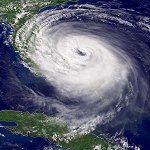-
(单词翻译:双击或拖选)
Fort Collins, Colorado
18 June 2007
We are now well into hurricane season in the western Atlantic area. The season lasts until November and forecasters say this year it will be active, producing as many as 17 “named” storms. They also say there is a high probability that at least one major hurricane will make landfall on the U.S. coast. VOA's Greg Flakus normally reports from the hurricane-prone Gulf1 of Mexico, at his base in Houston, but he went far afield, to Fort Collins, Colorado, to prepare this report on hurricane forecasting.
 |
| Hurricane Jeanne approaching Florida, September 2004 |
The forecasts put out by atmospheric4 scientists at Colorado State University have been fairly accurate over the past few decades, with the exception of last year, when lead researcher Phil Klotzbach says the unexpected warming of the Pacific ocean waters, known as el Niño, intervened. When Pacific waters are warm, storms are not drawn5 westward6 as strongly as they are when Pacific waters are cooler.
"Certainly, last year that was one of the reasons our forecast did not do very well,” says Klotzbach. “An el Niño came on that we did not expect. Also, several groups that try to predict el Niño, that is their primary focus, and they did not see it either."
Klotzbach says this year and the years to follow should see lots of big storms because of an overall warming of the Atlantic waters that began more than a decade ago.
"When the Atlantic is warm for 25 or 30 years, you tend to see more active hurricane seasons. Since 1995 we have had mostly active hurricane seasons. The only years that were not active were 1997, 2002, and 2006. All three of them were el Niño years."
The man who established the reputation of this research center and continues to guide it is 77-year-old professor emeritus7 William Gray. He says the United States and Caribbean areas may be in for some rough storm seasons for some time to come.
"How long will this last? No one can say for sure, but if the future is like the past, this should go on probably another 15 or 20 years," Gray says.
The Colorado State University forecast also includes probabilities of landfall in specific areas like southern Florida and the Gulf of Mexico. Both are above 50 percent this year. Gray says these probabilities are based to some extent on past events.
"Since the last hundred and some years there has been no landfall of a major storm in the Jacksonville area of north Florida, but half the category four and five storms that have struck the U.S. in the last century have occurred in southeast Florida."
Gray says hurricanes are likely to cause more death and destruction in the future as populations grow in coastal areas. He says the monster hurricane that hit Miami in 1926 would do far more harm if it came today.
"There weren't that many people living in Miami in 1926,” explains Gray. “Now the whole Gold Coast there, from Palm Beach south, there are about five or six million people there, so it would do tremendous damage."
Gray says people building homes in vulnerable areas should be using designs and material that will protect them and their property from storms. "If you just spent three or four percent more on your home, if you build a new one, you can build it to withstand much stronger winds."
But, as Hurricanes Katrina and Rita showed in 2005, much damage is also done by heavy rains and huge waves of water coming inland. In the end, Professor Gray says, people who live in coastal areas will have to accept the risk and the expense that may come with it.
 收听单词发音
收听单词发音
1
gulf

|
|
| n.海湾;深渊,鸿沟;分歧,隔阂 | |
参考例句: |
|
|
|
2
dread

|
|
| vt.担忧,忧虑;惧怕,不敢;n.担忧,畏惧 | |
参考例句: |
|
|
|
3
coastal

|
|
| adj.海岸的,沿海的,沿岸的 | |
参考例句: |
|
|
|
4
atmospheric

|
|
| adj.大气的,空气的;大气层的;大气所引起的 | |
参考例句: |
|
|
|
5
drawn

|
|
| v.拖,拉,拔出;adj.憔悴的,紧张的 | |
参考例句: |
|
|
|
6
westward

|
|
| n.西方,西部;adj.西方的,向西的;adv.向西 | |
参考例句: |
|
|
|
7
emeritus

|
|
| adj.名誉退休的 | |
参考例句: |
|
|
|















